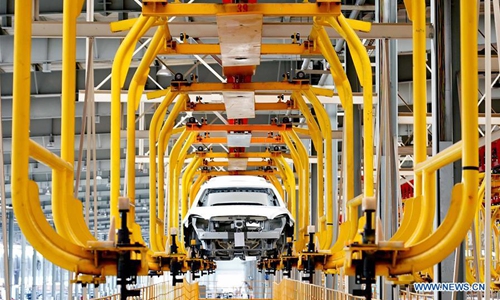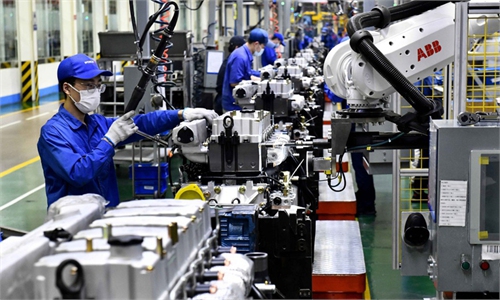
China's manufacturing PMI Photo: Xinhua
China's two major indexes measuring manufacturing activity of enterprises above a designated size and smaller ones have shown divergence in November, which analysts said offered insights gauging the vitality of different aspects of the world's second-largest economy.
Analysts also expect more policy support to be rolled out targeting small- and medium-sized enterprises (SMEs), helping alleviate their burdens.
China's official manufacturing purchasing managers' index (PMI), which tracks a wider scope of firms, rose to 50.1 from 49.2 in October, beating broad expectations and rebounding after two months of contraction.
The private Caixin manufacturing purchasing managers' index (PMI) stood at 49.9 in November, down 0.7 points from the previous month, indicating difficulties at smaller factories.
The 49.9 reading in the Caixin survey, which focuses mostly on smaller firms, dropped from 50.6 to below the neutral 50.0 mark, indicating that operating conditions remained broadly unchanged in November.
The majority of surveyed enterprises for the Caixin PMI are small and medium-sized enterprises (SMEs) whereas the official PMI surveys more large and state-owned enterprises, which usually respond to the changes in both the current situation and policy changes faster than SMEs, Zhou Jingtong, a senior economist from the Academy of the Bank of China, told the Global Times on Wednesday.
Wang Zhe, senior economist at Caixin Insight Group, said that supporting SMEs will remain a focus for policy-makers, as some enterprises are facing heavy cost pressures.
In the third quarter, the business difficulties of SMEs increased due to higher commodity and labor costs, as well as a power crunch, Zhou said.
The relevant authorities have implemented measures and policies such as extending the implementation of beneficial credit policies and tax cuts, and increasing support from the supply chain, to promote SMEs' sound development.
Chinese manufacturing output rose for the first time since July as power shortages eased. The survey found that the improvement in energy supply and firmer market conditions were significant drivers of higher production.
Analysts noted that supply in the manufacturing sector recovered, but demand weakened as the result of rising product prices and the ongoing COVID-19 pandemic, which also hurt external demand.
Inflationary pressure eased markedly, according to Wang, partly due to regulations effectively containing surging commodity prices. Production costs for manufacturing enterprises increased at a slower pace in November than October.
China is considering a new mix of tax and fee cuts to address the hardships facing small and micro-sized businesses and self-employed people, Premier Li Keqiang said during an inspection tour to the country's top market regulator in November, according to media reports.
Global Times

